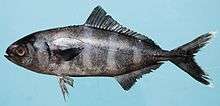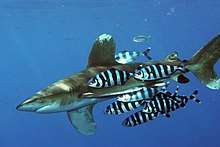Pilot fish
The pilot fish (Naucrates ductor) is a carnivorous fish of the trevally, or jackfish family, Carangidae.[3] It is widely distributed and lives in warm or tropical open seas.
| Pilot fish | |
|---|---|
 | |
| Scientific classification | |
| Kingdom: | Animalia |
| Phylum: | Chordata |
| Class: | Actinopterygii |
| Order: | Carangiformes |
| Family: | Carangidae |
| Subfamily: | Naucratinae |
| Genus: | Naucrates Rafinesque, 1810 |
| Species: | N. ductor |
| Binomial name | |
| Naucrates ductor | |
| Synonyms[2] | |
| |
Description
The pilot fish congregates around sharks, rays, and sea turtles, where it eats ectoparasites on, and leftovers around the host species;[4] younger pilot fish are usually associated with jellyfish and drifting seaweeds.[5] They are also known to follow ships, sometimes for long distances; one was found in County Cork, Ireland,[6] and many pilot fish have been sighted on the shores of England.[7][8] Their fondness for ships led the ancients to believe that they would navigate a ship to its desired course.[9]
The pilot fish's color is between dark blue and blackish-silver, with the belly being lighter in color.[10][11][12] The pilot fish is also known to have a temporary variation of color when excited; its dark-colored bars disappear, and its body turns silvery-white, with three broad blue patches on its back.[13] It can be recognized by its five to seven distinctive traverse bands,[14] which are of a much darker color than the rest of the body.[11] The pilot fish can grow up to 60–70 cm in length.[15]
The pilot fish is edible[16][17] and is said to taste good,[18][19] but it is rarely available due to its erratic behavior when caught.[20]

While pilot fish can be seen with all manner of sharks, they prefer accompanying the oceanic whitetip, Carcharhinus longimanus.[21] The pilot fish's relationship with sharks is a mutualist one; the pilot fish gains protection from predators, while the shark gains freedom from parasites.[22] It was often said by sailors that sharks and pilot fish share something like a "close companionship";[23] there were even tales of this fish following ships which had captured "their" shark for up to six weeks[24] and showing signs of distress in its absence.[25][26]
Whatever the veracity of such reports, it is extremely rare that a shark will feed on a pilot fish,[27] and smaller pilot fish are frequently observed swimming into sharks' mouths to clean away fragments of food from between their teeth. As Herman Melville put it,[28]
They have nothing of harm to dread,
But liquidly glide on his ghastly flank
Or before his Gorgonian head;
Or lurk in the port of serrated teeth
In white triple tiers of glittering gates,
And there find a haven when peril 's abroad,An asylum in jaws of the Fates![29]
These observations have led to the pilot fish's distinctive markings being copied for decals supplied as shark protection for surfboards.[30]
Etymology and metaphors
There are a few possible, conflicting etymologies for the term "pilot fish". One is that seafaring people believed that pilot fish, which would appear around the bow of their ships when they were close to land, were leading (or piloting) them back to port.[31] An alternative etymology is that pilot fish were once, erroneously,[32] thought to be piloting sharks to food,[33][34] or even (as legends have it) piloting ships, whales and swimmers to safety.[35]
In Greek mythology a sailor called Pompilos helped the nymph Okyrhoe when she was fleeing away from the god Apollo. The sailor moved the nymph from Miletus to Samos and the god punished him by making him a pilot fish.[36]
The pilot fish is sometimes used as a metaphor or simile; "they are like the pilot fish to the shark, serving to lead him to his victim".[37] Pilot fish are also used as a metaphor or simile for scavengers or looters which accompany a greater threat.
In popular culture
In the BBC science fiction series Doctor Who, the pilot fish were used in analogical terms for a robotic species who congregated around more dangerous life-forms, such as the Sycorax and the Racnoss. They appeared three times in the series; twice with David Tennant in "The Christmas Invasion" (2005) and "The Runaway Bride" (2006), and once with Matt Smith in "The Pandorica Opens" (2010).
In the Discworld novel Making Money, during a conspiracy to entrap Moist von Lipwig, Heretofore reflects on his current predicament and uncomfortable relationship with Cosmo Lavish and says "Does he think he's Vetinari? What do they call those fishes that swim alongside sharks, making themselves useful so they don't get eaten? That's me, that's what I'm doing, just hanging on, because it's much safer than letting go."[38]
Ernest Hemingway bitterly immortalised John Dos Passos as a "pilot fish" for the wealthy in A Moveable Feast, after falling out with him over the Spanish Civil War.[39]
References
- Smith-Vaniz, W.F.; Brown, J.; Pina Amargos, F.; Williams, J.T. & Curtis, M. (2015). "Naucrates ductor (errata version published in 2017)". IUCN Red List of Threatened Species. 2015: e.T190452A115322218. doi:10.2305/IUCN.UK.2015-4.RLTS.T190452A16643992.en.{{cite iucn}}: error: |doi= / |page= mismatch (help)
- Froese, Rainer and Pauly, Daniel, eds. (2019). "Naucrates ductor" in FishBase. August 2019 version.
- Greenberg, Idaz (1986). Guide to Corals & Fishes of Florida, the Bahamas and the Caribbean. Seahawk Press. pp. 2–3. ISBN 0-913008-08-7.
- McEachran, John D.; Fechhelm, Janice D. (1998). Fishes of the Gulf of Mexico: Myxiniformes to Gasterosteiformes. University of Texas Press. p. 287. ISBN 0-292-70634-0.
- Eschmeyer, William N.; Herald, Earl Stannard (1999). A Field Guide to Pacific Coast Fishes. Houghton Mifflin Books. p. 208. ISBN 0-395-26873-7.
- Thompson, William (1856). The Natural History of Ireland. Reeve, Benham and Reeve. p. 95. ISBN 0-900761-45-8.
- Couch, Jonathan (1863). A History of the Fishes of the British Islands. Groombridge & Sons. p. 109.
- Yarrell, William (1841). A History of British Fishes (2nd. ed.). John van Voorst. p. 170.
The pilot-fish has been so often seen, and occasionally taken on our southern coast, as to be entitled to a place among British Fishes[.]
- Patterson, Robert (1849). First Steps to Zoology. Simms and McIntyre. p. 149.
[The pilot fish is] supposed by the ancients to have pointed out to navigators their desired course, and borne them company during their voyage.
- Goldsmith, Oliver (1810). A History of the Earth and Animated Nature. p. 159.
- Eschmeyer & Herald 1999, p. 208.
- Randall, John; Allen, Gerald; Steen, Roger (1997). Fishes of the Great Barrier Reef and Coral Sea. University of Hawaii Press. p. 164. ISBN 0-8248-1895-4.
- Eschmeyer & Herald, p. 208.
- Goldsmith 1810, p. 159.
- Various sources give different figures:
- Eschmayer & Herald 1999, p. 208, claims a maximum of 61 cm, averaging less than 30cm in the studied area (the Pacific).
- Randall, Allen & Steen 1997, p. 164, gives a maximum figure of 70 cm, as does FishBase.
- An average size of 60cm is given by Jennings, Gerald (1997). The Sea and Freshwater Fishes of Australia and New Guinea. Calypso Publications. p. 163. ISBN 0-906301-62-9.
- An older source gives a figure of "about a foot". See the third volume of Orr, William Somerville (1865). Orr's Circle of the Sciences. Houlston & Stoneman. p. 50. ISBN 1-142-00237-3..
- Goadby, Peter (1963). Sharks and Other Marine Predators. Melbourne: Jacaranda Press. p. 22.
- "Naucrates ductor". Integrated Taxonomic Information System. Retrieved June 24, 2005.
- Orr 1865, p. 50. "Its flesh is said to be very good."
- Yarrell 1841, p. 172. "After this the two [pilot] fish separated; but they were both taken the same evening, and, when dressed the next day, were found to be excellent eating."
- Dixon, C. C. (November 1925). "The Sargasso Sea". The Geographical Journal. 66 (5): 440. doi:10.2307/1782665. JSTOR 1782665.
They take the hook readily, but go quite insane when hooked, and are difficult to land in spite of their size, 6 to 16 inches.
- Stafford-Deitsch, Jeremy (2000). Sharks of Florida, the Bahamas, the Caribbean and the Gulf of Mexico. Trident Press. p. 32. ISBN 1-900724-45-6.
- Webster, Stephen (2003). Thinking about Biology. Cambridge University Press. p. 24. ISBN 0-521-59059-0.
- Couch 1863, p. 110–111.
- Murray, Hugh; Wilson, James; Greville, R. K.; Jameson, Robert; Ainslie, Whitelaw; Rhind, William; Wallace, Prof.; Dalrymble, Clarence (1832). Historical and Descriptive Account of British India, from the Most Remote Period to the Present Time. J. & J. Harper. p. 337.
- Schomburgk, Robert Hermann (1848). History of Barbados: Comprising a Geographical and Statistical Description of the Island. p. 669. ISBN 0-7146-1948-5.
- Gudger, E. W. (March 1929). "Some Instances of Supposed Sympathy Among Fishes". The Scientific Monthly. 28 (3): 267. Bibcode:1929SciMo..28..266G.
- "The Deep-Sea Fishes Collected by the Talisman". Science. 3 (68): 623–8. May 23, 1884. Bibcode:1884Sci.....3..623.. doi:10.1126/science.ns-3.68.623. PMID 17844329.
It seems that Naucrates acts as a guide for the sharks, and that the latter, in recognition of its services, never pursue it.
- Turco, Lewis (1986). Visions and Revisions of American Poetry. University of Arkansas Press. p. 65. ISBN 0-938626-50-7.
'The Maldive Shark' is as close to perfection as Melville ever came in his verse poetry.
- The Maldive Shark, in Melville, Herman (1888). John Marr and Other Sailors. Faculty Publications, Unl Libraries. The De Vinne Press. p. 90. ISBN 0-8414-6029-9.
- Hurley, Timothy (2003-11-06). "Company sold out of anti-shark device". The Honolulu Advertiser. Retrieved 2007-07-26.
Sharkcamo sells rash guards and decals for surfboards and bodyboards that have zebralike stripes that mimic the pattern of certain fish—poisonous fish, cleaner fish, pilot fish and remoras—that sharks do not choose as prey.
See also the Shark Camo website. - "Pilot Fish". The London Encyclopædia, or, Universal Dictionary of Science, Art, Literature, and Practical Mechanics. XVII. 1839. p. 396.
Seafaring people observe that this fish frequently accompanies their vessels; and, as they see it generally towards the fore part of the ship, they imagined that it was guiding and tracing out the course of the vessel, and hence it received the name of pilot-fish.
- Stafford-Deitsch 2000, p. 32. "The myth that pilotfishes guide their host to prey is erroneously derived from the fact that pilotfishes [...] often ride the pressure wave immediately in front of the snout of their host."
- Andrews, Roy Chapman (1940). This Amazing Planet. G.P. Putnam's Sons. p. 88.
- Stedman, John Gabriel (1813). Narrative of a Five Years' Expedition against the Revolted Negroes of Surinam in Guiana on the Wild Coast of South America from the Years 1772–1777. p. 400. ISBN 0-87636-015-0.
The pilot-fish ought here also to be noticed: this [...] is said not only to feed upon the gills of the shark, but to direct it to its prey, from which singularity originates its name.
- Eschmeyer & Herald 2002, p. 209. "The name Pilotfish comes from legendary tales of this species leading lost swimmers, ships, or whales to safety."
- Athenaeus, Deipnosofistae 283e and Claudius Aelianus, De natura animalium 15.23.
- Watt, G. D. (1855). Journal of Discourses by Brigham Young. II. F. D. Richards. p. 188.
- Pratchett, Terry (2008). Making Money. Discworld novel 36. New York: Random House. p. 278. ISBN 9781407034010. Retrieved 25 March 2016.
- Hemingway, Ernest (2014). "The Pilot Fish and the Rich". Moveable Feast: The Restored Edition. New York: Simon and Schuster. p. 195. ISBN 9781476770420. Retrieved 25 March 2016.
External links
| Wikispecies has information related to Naucrates ductor |
| Wikisource has the text of the 1920 Encyclopedia Americana article Pilot-fish. |
- Naucrates ductor at FishBase
- Photos of Pilot fish on Sealife Collection
